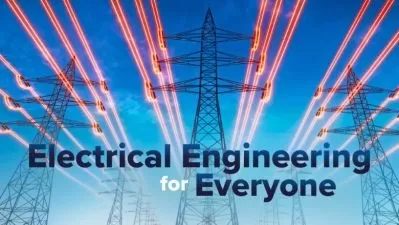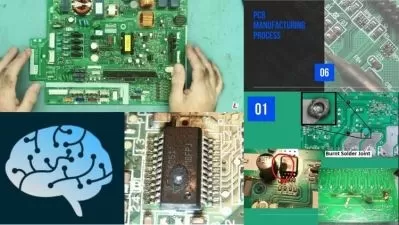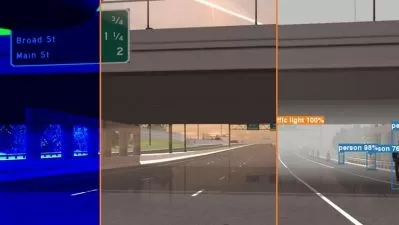1D Lithium Air battery Simulation in COMSOL Multiphysics
Bibhatsu Kuiri
1:36:14
Description
Lithium Air Battery Simulation in COMSOL Multiphysics. 1D simulation multiphysics for battery & energy storage use
What You'll Learn?
- COMSOL Multiphysics
- Simulation
- Advanced Multiphysics Simulation
- Lithium battery
- Air Battery
- Energy Storage Simulation
- COMSOL Advanced Simulation
Who is this for?
What You Need to Know?
More details
DescriptionWelcome to this course!
This course is on 1D Lithium-Ion Battery Multiphysics Simulations.
In this course, you will learn advanced Lithium Battery Simulations using multiple Physics interfaces. This course will explain how to actually work with complicated simulations such as a battery.
If you are totally new, I would suggest first complete our course on "Learn COMSOL Multiphysics simulation: Basics to Advanced" as this is a bit advanced course, even though I tried to explain it as easy as possible.
About the Instructor. am I ready to instruct others?
I have instructed more than 5000 students till the year 2021, across 105 countries.
I have publications in top journals like Nature Materials where I have modelled devices in council multiphysics.
Till 2021 I have 17 international publications almost all containing some of the other modelling and simulation involving finite element simulation or DFT simulation or analysis using Matlab Python or Simulink.
I am the author of the best-selling COMSOL courses on Udemy.
___________________________________________________________________________________
Lithium-ion batteries have become the most common rechargeable batteries for consumer electronics and automotive applications due to their high energy densities, decent power density, relatively high cell voltages, and low weight-to-volume ratios.
Brief feature of this course:
1D simulation of Complex Lithium-Ion battery Simulation.
The files and parameter values so that you can watch and prepare your own model.
Basic understanding of how to actually do simulations.
HIGH-QUALITY lectures
Battery Simulation is a demanding topic in Energy Storage and Next Generation Energy Demand. Rechargeable lithium-air batteries have recently attracted great interest mainly due to their high energy density. A unit cell of a lithium-air battery typically consists of a thin lithium sheet as the negative electrode, a porous carbon electrode filled with oxygen/air as the positive electrode, and a separator material between the electrodes. The organic electrolyte used consists of a dissolved lithium salt in an aprotic solvent. The oxidation of lithium at the anode and reduction of oxygen at the cathode induces a current flow.
In this battery simulation course, the discharge of a lithium-air battery is simulated using the Lithium-Ion Battery interface. The transport of oxygen (from external air) in the porous carbon electrode is modelled using the Transport of Diluted Species in Porous Media interface in COMSOL Multiphysics. The electrochemical reaction of oxygen reduction in the carbon electrode leads to changes in the concentration of the reaction product and electrode porosity. In this example, model analysis is done for a range of discharge current densities. A comparison of the oxygen concentration, porosity, and film thickness in the positive electrode at low and high discharge current densities is done to understand their effect on the cell voltage profiles. This model can be used for studying the performance of lithium-air batteries and for providing insights toward cell design.
Note that this is a very specific simulation course which is good to get an idea of how battery simulation is actually done. Consider this as a starting point in the simulation of batteries. After trying out the 1D simulation, you can try out how you can implement the same idea in 2D and 3D. The course is prepared with the help of the Official COMSOL simulation model and documentations.
Who this course is for:
- Students
- Researchers
- Teachers
- Industrial Experts
- Energy Storage
- Battery Experts
Welcome to this course!
This course is on 1D Lithium-Ion Battery Multiphysics Simulations.
In this course, you will learn advanced Lithium Battery Simulations using multiple Physics interfaces. This course will explain how to actually work with complicated simulations such as a battery.
If you are totally new, I would suggest first complete our course on "Learn COMSOL Multiphysics simulation: Basics to Advanced" as this is a bit advanced course, even though I tried to explain it as easy as possible.
About the Instructor. am I ready to instruct others?
I have instructed more than 5000 students till the year 2021, across 105 countries.
I have publications in top journals like Nature Materials where I have modelled devices in council multiphysics.
Till 2021 I have 17 international publications almost all containing some of the other modelling and simulation involving finite element simulation or DFT simulation or analysis using Matlab Python or Simulink.
I am the author of the best-selling COMSOL courses on Udemy.
___________________________________________________________________________________
Lithium-ion batteries have become the most common rechargeable batteries for consumer electronics and automotive applications due to their high energy densities, decent power density, relatively high cell voltages, and low weight-to-volume ratios.
Brief feature of this course:
1D simulation of Complex Lithium-Ion battery Simulation.
The files and parameter values so that you can watch and prepare your own model.
Basic understanding of how to actually do simulations.
HIGH-QUALITY lectures
Battery Simulation is a demanding topic in Energy Storage and Next Generation Energy Demand. Rechargeable lithium-air batteries have recently attracted great interest mainly due to their high energy density. A unit cell of a lithium-air battery typically consists of a thin lithium sheet as the negative electrode, a porous carbon electrode filled with oxygen/air as the positive electrode, and a separator material between the electrodes. The organic electrolyte used consists of a dissolved lithium salt in an aprotic solvent. The oxidation of lithium at the anode and reduction of oxygen at the cathode induces a current flow.
In this battery simulation course, the discharge of a lithium-air battery is simulated using the Lithium-Ion Battery interface. The transport of oxygen (from external air) in the porous carbon electrode is modelled using the Transport of Diluted Species in Porous Media interface in COMSOL Multiphysics. The electrochemical reaction of oxygen reduction in the carbon electrode leads to changes in the concentration of the reaction product and electrode porosity. In this example, model analysis is done for a range of discharge current densities. A comparison of the oxygen concentration, porosity, and film thickness in the positive electrode at low and high discharge current densities is done to understand their effect on the cell voltage profiles. This model can be used for studying the performance of lithium-air batteries and for providing insights toward cell design.
Note that this is a very specific simulation course which is good to get an idea of how battery simulation is actually done. Consider this as a starting point in the simulation of batteries. After trying out the 1D simulation, you can try out how you can implement the same idea in 2D and 3D. The course is prepared with the help of the Official COMSOL simulation model and documentations.
Who this course is for:
- Students
- Researchers
- Teachers
- Industrial Experts
- Energy Storage
- Battery Experts
User Reviews
Rating
Bibhatsu Kuiri
Instructor's Courses
Udemy
View courses Udemy- language english
- Training sessions 17
- duration 1:36:14
- English subtitles has
- Release Date 2024/03/11

















